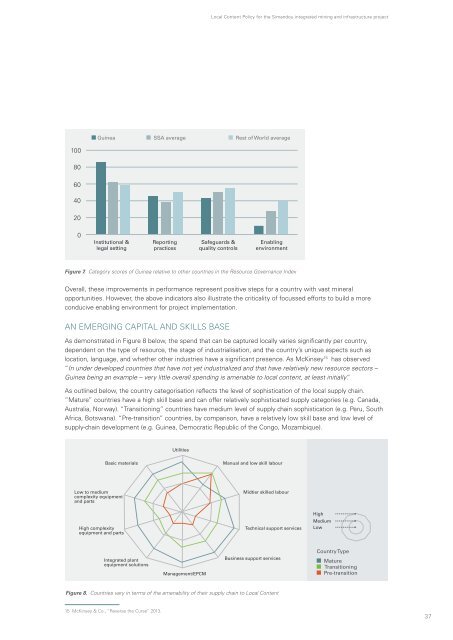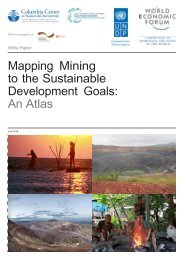20Nwews
20Nwews
20Nwews
You also want an ePaper? Increase the reach of your titles
YUMPU automatically turns print PDFs into web optimized ePapers that Google loves.
Local Content Policy for the Simandou integrated mining and infrastructure project<br />
Guinea SSA average Rest of World average<br />
100<br />
80<br />
60<br />
40<br />
20<br />
0<br />
Institutional &<br />
legal setting<br />
Reporting<br />
practices<br />
Safeguards &<br />
quality controls<br />
Enabling<br />
environment<br />
Figure 7. Category scores of Guinea relative to other countries in the Resource Governance Index<br />
Overall, these improvements in performance represent positive steps for a country with vast mineral<br />
opportunities. However, the above indicators also illustrate the criticality of focussed efforts to build a more<br />
conducive enabling environment for project implementation.<br />
AN EMERGING CAPITAL AND SKILLS BASE<br />
As demonstrated in Figure 8 below, the spend that can be captured locally varies significantly per country,<br />
dependent on the type of resource, the stage of industrialisation, and the country’s unique aspects such as<br />
location, language, and whether other industries have a significant presence. As McKinsey 15 has observed<br />
“In under developed countries that have not yet industrialized and that have relatively new resource sectors –<br />
Guinea being an example – very little overall spending is amenable to local content, at least initially.”<br />
As outlined below, the country categorisation reflects the level of sophistication of the local supply chain.<br />
“Mature” countries have a high skill base and can offer relatively sophisticated supply categories (e.g. Canada,<br />
Australia, Norway). “Transitioning” countries have medium level of supply chain sophistication (e.g. Peru, South<br />
Africa, Botswana). “Pre-transition” countries, by comparison, have a relatively low skill base and low level of<br />
supply-chain development (e.g. Guinea, Democratic Republic of the Congo, Mozambique).<br />
Utilities<br />
Basic materials<br />
Manual and low skill labour<br />
Low to medium<br />
complexity equipment<br />
and parts<br />
Midtier skilled labour<br />
High<br />
High complexity<br />
equipment and parts<br />
Technical support services<br />
Medium<br />
Low<br />
Integrated plant<br />
equipment solutions<br />
Management/EPCM<br />
Business support services<br />
Country Type<br />
Mature<br />
Transitioning<br />
Pre-transition<br />
Figure 8. Countries vary in terms of the amenability of their supply chain to Local Content<br />
15 McKinsey & Co., “Reverse the Curse” 2013.<br />
37






